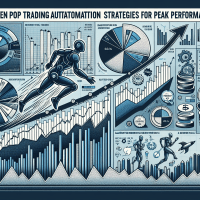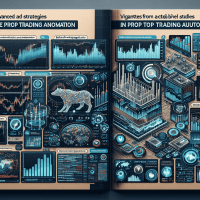Proven Prop Trading Automation: Advanced Strategies for Prop Firms
In an industry where milliseconds matter and precision is key, prop trading automation is revolutionizing the way firms approach backtesting and live trading. From advanced algorithmic strategies to cutting-edge backtesting tools, prop traders are now better equipped than ever to optimize performance and mitigate risk. This article offers actionable insights tailored for traders, quants, and risk managers looking to stay ahead in the competitive world of proprietary trading.
Understanding Prop Trading Automation
Prop trading automation involves using robust software and tools to execute trading strategies automatically, minimizing errors and increasing efficiency. In proprietary trading, where significant capital and resources are on the line, automation plays a crucial role in ensuring decisions are based on data-driven analysis rather than emotion. This approach not only accelerates the decision-making process but also supports consistency in trading strategies.
As markets become more volatile and technological advancements continue, prop trading automation is evolving. The integration of automated backtesting and live strategies allows firms to test, optimize, and deploy algorithms with speed and accuracy, ensuring they can adapt quickly to changing market dynamics.
Figure 1: A screenshot showing a prop trading automation dashboard with detailed analytics and real-time performance metrics.
Advanced Backtesting Strategies for Prop Traders
Efficient backtesting is the foundation of any successful automated trading strategy. In prop trading, it is essential that the methodology not only simulates historical performance but also addresses common pitfalls:
- Overfitting: Creating a model that fits historical data perfectly but fails in live markets.
- Survivorship Bias: Ignoring the performance of companies that have exited the market, which can skew backtesting results.
- Look-ahead Bias and Data Snooping: Using data that would not have been available during the time of trading to inadvertently boost performance metrics.
Pro Tip: Implement out-of-sample testing alongside walk-forward optimization to fine-tune strategies and avoid data overfitting. Walk-forward optimization simulates real market environments by constantly adjusting parameters as new data becomes available, ensuring the strategies are robust under various market conditions.
Essential Backtesting Considerations
Effective backtesting in a prop trading context must include:
- Detailed simulations using high-quality tick or bar data.
- Incorporating realistic commission, slippage, and latency factors to simulate actual market conditions.
- Automated parameter optimization to test multiple configurations quickly.
- Scenario analysis and stress testing to evaluate strategy robustness during market shocks.
Comprehensive Tool Comparisons for Prop Trading
A crucial aspect of prop trading automation is the selection and effective use of backtesting and live trading platforms. Below is a detailed comparison of several widely recognized tools in the industry:
| Tool | Backtesting Features | Data Quality | Integration Capabilities | Pricing & Use Cases |
|---|---|---|---|---|
| TradingView | Vectorized backtesting with script optimization using Pine Script. | Robust historical data for multiple asset classes. | API integrations with brokers; community scripts. | Free tier available; ideal for both beginners and prop firms requiring quick visual analysis. |
| MetaTrader 5 | Event-driven backtesting supporting MQL5 scripts with detailed reporting. | Comprehensive data feeds for forex and stocks. | Broker integration with automated trading and expert advisors. | Cost-effective; popular among prop traders and retail alike. |
| NinjaTrader | Advanced simulation and strategy optimization including stress testing. | High-quality data, particularly for futures and forex. | Excellent API integrations; compatibility with third-party analytics. | Commercial pricing with free simulation; best for experienced traders and prop firms. |
Each tool offers unique strengths. For instance, TradingView appeals to those looking for a balance between ease of use and comprehensive data analytics, while NinjaTrader provides deep customization for those needing enhanced simulation capabilities. Prop firms, in particular, benefit from tools with extensive API integration and team collaboration features.
Real-World Case Studies: Navigating Prop Trading Challenges
Let’s consider a case study from an anonymous mid-sized prop trading firm:
Case Study: Overcoming Overfitting with Advanced Backtesting
The firm faced repeated challenges with overfitting, where historically optimized strategies performed poorly in live sessions. By integrating TradingView’s automated backtesting and using walk-forward optimization techniques, they were able to reduce overfitting risks. The process included:
- Data Quality Improvement: Upgrading to high-resolution tick data.
- Parameter Optimization: Automating parameter sweeps using NinjaTrader’s stress testing modules.
- Forward Testing: Integrating out-of-sample testing protocols before full live deployment.
As a result, the firm experienced a measurable improvement in key metrics – the Sharpe ratio increased by 30%, and maximum drawdown was reduced by 25%. This case highlights the practical benefits of combining robust backtesting methodologies with advanced automated tools.
Expert Guidance and Pro Tips
Before deploying any automated prop trading strategy, consider these advanced guidelines:
- Refine Your Data Strategy: Ensure your historical data is accurate and granular. Investigate sources such as Interactive Brokers or QuantConnect for premium datasets.
- Automate Reporting: Leverage tools that offer automated report generation, such as Trade Ideas or NinjaTrader, to provide real-time insights on strategy performance.
- Integrate Risk Management Practices: Use automated alerts for instantaneous deviation from expected risk thresholds. A well-documented risk management checklist is critical. Below is an outline for a Risk Management Checklist:
Risk Management Checklist:
- Set stop-loss and take-profit levels based on historical volatility.
- Include dynamic position sizing rules tied to current drawdown levels.
- Monitor key risk metrics such as maximum drawdown, Sharpe ratio, and profit factor continuously.
- Regularly recalibrate the strategy using out-of-sample data to avoid performance degradation.
Code Snippet for a Simple Backtrader Strategy (Python)
import backtrader as bt
class SimpleStrategy(bt.Strategy):
def __init__(self):
self.sma = bt.indicators.SimpleMovingAverage(self.data.close, period=20)
def next(self):
if self.data.close[0] > self.sma[0]:
self.buy()
elif self.data.close[0] < self.sma[0]:
self.sell()
cerebro = bt.Cerebro()
# Add data feed and strategy
# cerebro.adddata(datafeed)
cerebro.addstrategy(SimpleStrategy)
result = cerebro.run()
Figure 2: A performance chart generated by NinjaTrader, illustrating key metrics such as drawdown and Sharpe ratio improvements during backtesting.
Regulatory Landscape and Compliance in Prop Trading
Automation in prop trading must navigate stringent regulatory frameworks. Main regulatory bodies such as MiFID II in Europe, ESMA, and NFA guidelines in the U.S. impose rigorous standards on data reporting, transparency, and risk management. Prop firms are urged to implement compliance tools integrated within their automated systems, ensuring that all trading activities are fully compliant with current regulations.
For example, firms using platforms like MetaTrader 5 can benefit from built-in compliance checks, while tools like Interactive Brokers offer automated trade reporting features. Staying informed on regulatory changes and regularly updating trading protocols is essential to avoid potential fines and legal complications.
Conclusion and Next Steps
The landscape of prop trading automation is evolving rapidly. With advanced backtesting methodologies, powerful trading tools, and a keen eye on regulatory compliance, prop traders can enhance performance significantly while mitigating risks.
Next Steps: If you are a prop trader looking to refine your automation strategy, consider integrating a robust risk management checklist along with tools like TradingView, MetaTrader 5, and NinjaTrader. For further insights, read our Advanced Risk Management Strategies for Prop Traders and Prop Trading Performance Optimization articles.
For a detailed checklist on ensuring comprehensive risk management in your prop trading strategies, download our complete Risk Management Checklist and join our upcoming webinar on advanced trading automation techniques.
Stay ahead of the curve by continually refining your strategies with deep data analysis and automated backtesting – because in the world of prop trading, automation isn’t just an advantage, it’s a necessity.
Content updated as of October 2023. Always consult a compliance professional for the latest regulatory guidelines.







